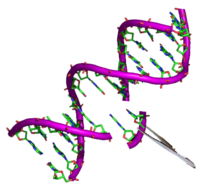
Photo from wikipedia
CRISPR-Cas9 technology is a very efficient functional analysis tool and has been developed in several insects to edit their genome through injection of eggs with guide RNAs targeting coding sequences… Click to show full abstract
CRISPR-Cas9 technology is a very efficient functional analysis tool and has been developed in several insects to edit their genome through injection of eggs with guide RNAs targeting coding sequences of genes of interest. However, its implementation in aphids is more challenging. Aphids are major pests of crops worldwide that alternate during their life cycle between clonality and sexual reproduction. The production of eggs after mating of sexual individuals is a single yearly event and is necessarily triggered by a photoperiod decrease. Fertilized eggs then experience an obligate 3-month diapause period before hatching as new clonal colonies. Taking into consideration these particularities, we developed in the pea aphid Acyrthosiphon pisum a step-by-step protocol of targeted mutagenesis based on the microinjection within fertilized eggs of CRISPR-Cas9 components designed for the editing of a cuticular protein gene (stylin-01). This protocol includes the following steps: i) the photoperiod-triggered induction of sexual morphs (2 months), ii) the mating and egg collection step (2 weeks), iii) egg microinjection and melanization, iv) the 3-month obligate diapause, v) the hatching of new lineages from injected eggs (2 weeks) and vi) the maintenance of stable lineages (2 weeks). Overall, this 7-month long procedure was applied to three different crosses in order to estimate the impact of the choice of the genetic combination on egg production dynamics by females as well as hatching rates after diapause. Mutation rates within eggs before diapause were estimated at 70-80%. The hatching rate of injected eggs following diapause ranged from 1 to 11% depending on the cross and finally a total of 17 stable lineages were obtained and maintained clonally. Out of these, 6 lineages were mutated at the defined sgRNAs target sites within stylin-01 coding sequence, either at the two alleles (2 lineages) or at one allele (4 lineages). The final germline transmission rate of the mutations was thus around 35%. Our protocol of an efficient targeted mutagenesis opens the avenue for functional studies through genome editing in aphids.
Journal Title: Insect biochemistry and molecular biology
Year Published: 2019
Link to full text (if available)
Share on Social Media: Sign Up to like & get
recommendations!